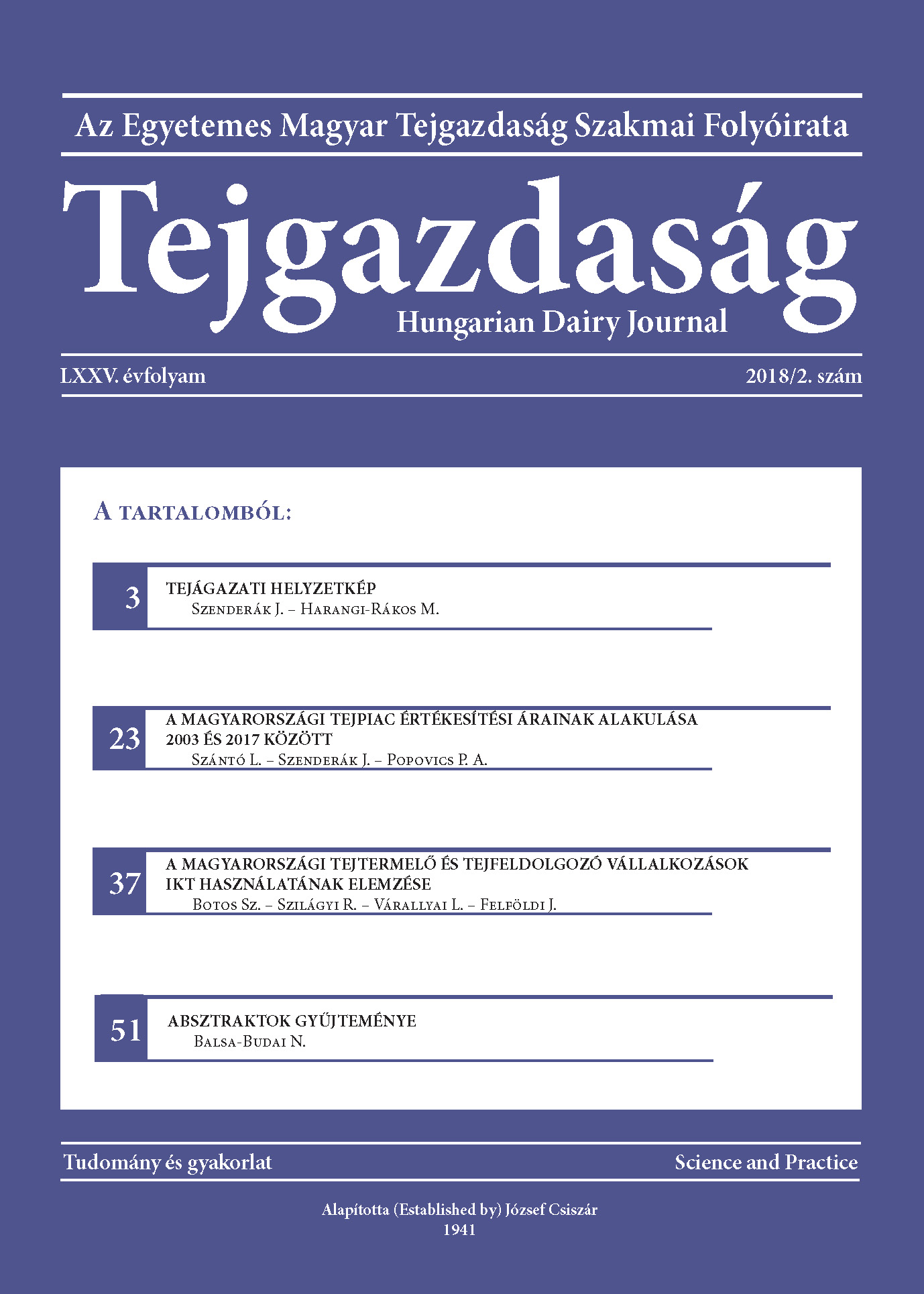Vol. 75 No. 2 (2018): Tejgazdaság
##issue.tableOfContents##
Articles
-
The Situation of Dairy Industry
3-21Views:192The increasing household incomes change the volume and the structure of the human consumption. There is a strong correlation between the changes in diet and the rapid urbanisation. Moving to the urban area often coincedes with a higher level of lifestyle which in turn can decrease the share of the agriculture labor force. Nowadays, more than half of the population lives in urban areas, but this share can be 70% until 2050 (FAO, 2011). Milk and dairy products are major items in the changing consumption structure. The consumers with mostly starch based diets are likely to shift to higher added value products when their income per capita increases. Majority of these products are milk and dairy or meat products. On the supply side, weather shocks can abruptly change the production volume and as a supply shock, they may increase the food price volatility. In the recent years, the gap remained constant between the production and the consumption, thus food prices have decreased (FAO, 2017). Between 1960 and 2010, the population has increased by some 230%, while the meat consumption by 450% (from 65 million tons to 290 million tons) (OECD – FAO, 2017). While the meat production and export are expected to increase moderately, the EU milk production may expand by 1% and its share from the international agricultural trade will increase in the future. The EU’s dairy sector aims to achieve a more marketoriented framework, which affects the Hungarian stakeholders as well. The processing and retail segment can be characterised with high concentration and strong bargaining power in general. Dairy sector appears to be purely demand-driven. The level of the individual stakeholders’ cost price is not taken into account during the market’s price setting, which creates strong competition. In the next years, higher market competition and further concentration are expected. Market position will be determined by one’s competitiveness and the level of cooperation among the stakeholders.
PDF (Hungarian)277 -
The Progress of the Hungarian Dairy Prices Between 2003 and 2017
23-35Views:154There were notable changes in the dairy industry from 2012 onwards that seriously affected the Hungarian dairy market. The main events were the introduction of the Milk Package in 2012, the beginning of the Russian import ban in 2014 and the abolition of the milk quota system in 2015. These events affected the development of the domestic dairy industry, and at the same time, the Hungarian dairy sector faces long term challenges. The aim of our research is to analyse the dairy price developments between 2003 and 2017. We compare the Hungarian producer and consumer prices over time and we analyse the relationship between the domestic prices and some of the international prices as well. We calculated the coefficient of variation, price ratios and correlation for different time periods. The results indicate that there has been a strong market integration between the domestic and the international market since 2003.
PDF (Hungarian)183 -
Analysing ICT Usage of Hungarian Milk Producers and Milk Processors
37-49Views:184Milk production and processing is one of the main agrofood sectors in Hungary. In 2016, the number of enterprises operating in milk production and milk processing sector was 741 and 80, respectively. Advanced information systems enable us to attain more and thorough data on their operation and performance and the analysis of these data is crucial for the evaluation of their situation in the sector. These data sets are important for monitoring and assessing the performance of different sectors. Hungarian Central Statistical Office provides multidimensional databases, while financial and additional information of more than half of the operating enterprises are available in EMIS database. As a complementary database, Institute of Applied Informatics and Logistics has prepared a questionnaire for survey the ICT (Information and Communication Technologies) usage characteristics of enterprises operating in the agro-food supply chain (producers and processors). The survey was conducted in the fourth quarter of 2017 and using structured questionnaire and responses are recorded by a market research company contacting the leaders or a management member of the enterprises. The sample has been selected by stratified sampling based on statistics of Hungarian Central Statistical Office (HCSO). Enterprise size based on staff employed and region at NUTS-2 level were the basis of sampling. Data set contains data about 500 enterprises operating in sectors related to agriculture and food industry (355 are operating in the production part, 145 in the processing part of the chain). 38 enterprises operating in the milk sector from the whole sample (28 belong to milk production and 10 to milk processing sector). The main objective of current article is to determine the difference between food producers and food processors, and separately between milk producers and milk processors regarding their evaluation of ICT devices in their partnerships an the internet-based solutions for certain business activities. Respondents assessed the importance of ICT on 5-point Likert scale relating to four business activities (communication; data storage and exchange, preparing documents; logistics; marketing). To determine the difference, two-sample t-test has been applied. Our results show significant difference only in the case of bulk sample, between food producers and food processors, in the evaluation of ICT devices for marketing purposes. The mean of scores given by food processors was significantly higher (Sig. (2-tailed)=0,0134 and t-value=-2,4829). There is no siginificant difference between milk producers and milk processors, however, the means of scores given by the latter for the importance of ICT tools were higher in the case of each four business activites.
PDF (Hungarian)255

